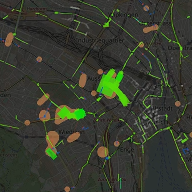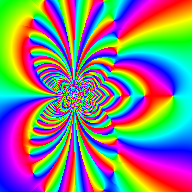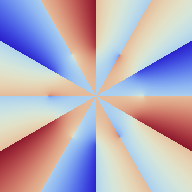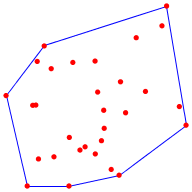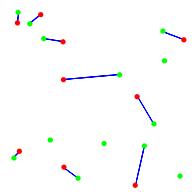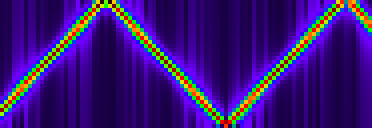Library for tensor computations in Java, version 0.8.1
The tensor library was developed with the following objectives in mind
- support for exact precision using integer fractions
- support for calculation with physical units
- suitable for use in safety-critical real-time systems
- API and string expressions inspired by
Mathematica
Diverse projects rely on the tensor library:
|
Mobility-on-Demand |
SwissTrolley plus |
Motion Planning |
Autonomous Gokart |
- multi-dimensional arrays: scalars, vectors, matrices, n-linear forms, Lie-algebra ad-tensor, ...
- unstructured, nested tensors, for instance
{{1+2*I[A], -3/4}, {{5.678}, 9[kg*s^-1], 2[m^3]}} - scalars are real-, or complex numbers, from finite fields, or quantities with physical units
- values are encoded as exact integer fractions, in double precision, and as
java.math.BigDecimal - probability distributions for random variate generation: Binomial-, Poisson-, Exponential-distribution, etc.
- matrix functions
LinearSolve,SingularValueDecomposition,QRDecomposition, etc. - parametric functions
LinearInterpolation,BSplineFunction, etc. - window functions: Gaussian, Hamming, Hann, Blackman, etc.
- spectral analysis:
Fourier,SpectrogramArray, etc. - import from and export to
Mathematica,CSV, and image files
|
Gamma function |
Trigonometry |
Nylander's formula |
Newton's method |
Solving systems of linear equations
Tensor matrix = Tensors.matrixInt(new int[][] { { 2, -3, 2 }, { 4, 9, -3 }, { -1, 3, 2 } });
System.out.println(Pretty.of(Inverse.of(matrix)));
[
[ 9/37 4/37 -3/37 ]
[ -5/111 2/37 14/111 ]
[ 7/37 -1/37 10/37 ]
]Linear programming
Tensor x = LinearProgramming.maxLessEquals( //
Tensors.vector(1, 1), // rewards
Tensors.fromString("{{4, -1}, {2, 1}, {-5, 2}}"), // matrix
Tensors.vector(8, 7, 2)); // rhs
System.out.println(x);
{4/3, 13/3}Null-space
Tensor matrix = Tensors.fromString("{{-1/3, 0, I}}");
System.out.println(Pretty.of(NullSpace.of(matrix)));
[
[ 1 0 -I/3 ]
[ 0 1 0 ]
]Statistics
Distribution distribution = HypergeometricDistribution.of(10, 50, 100);
System.out.println(RandomVariate.of(distribution, 20));
PDF pdf = PDF.of(distribution);
System.out.println("P(X=3)=" + pdf.at(RealScalar.of(3)));
{6, 5, 1, 4, 3, 4, 7, 5, 7, 4, 6, 3, 5, 4, 5, 4, 6, 2, 6, 7}
P(X=3)=84000/742729The tensor library implements Quantity, i.e. numbers with physical units.
Several algorithms are verified to work with scalars of type Quantity.
Tensor matrix = Tensors.fromString( //
"{{60[m^2], 30[m*rad], 20[kg*m]}, {30[m*rad], 20[rad^2], 15[kg*rad]}, {20[kg*m], 15[kg*rad], 12[kg^2]}}");
CholeskyDecomposition cd = CholeskyDecomposition.of(matrix);
System.out.println(cd.diagonal());
System.out.println(Pretty.of(cd.getL()));
System.out.println(cd.det().divide(Quantity.of(20, "m^2*rad")));
{60[m^2], 5[rad^2], 1/3[kg^2]}
[
[ 1 0 0 ]
[ 1/2[m^-1*rad] 1 0 ]
[ 1/3[kg*m^-1] 1[kg*rad^-1] 1 ]
]
5[kg^2*rad]The units of a quantity are chosen by the application layer.
For instance, Quantity.of(3, "Apples") is valid syntax.
The tensor library contains the resource /unit/si.properties that encodes the SI unit system in the familiar strings such as m, kg, s, but the use of this convention is optional.
The example below makes use of these provided definitions
Scalar mass = Quantity.of(300, "g"); // in gram
Scalar a = Quantity.of(981, "cm*s^-2"); // in centi-meters per seconds square
Scalar force = mass.multiply(a);
System.out.println(force);
Scalar force_N = UnitConvert.SI().to(Unit.of("N")).apply(force);
System.out.println(force_N);
294300[cm*g*s^-2]
2943/1000[N]The arithmetic for the scalar type Quantity was developed in collaboration with the project SwissTrolley+.
|
Graham's scan |
Sphere fit |
Hungarian algorithm |
Weiszfeld’s method |
Tensors of rank 3
Tensor ad = LieAlgebras.so3();
Tensor x = Tensors.vector(7, 2, -4);
Tensor y = Tensors.vector(-3, 5, 2);
System.out.println(ad);
System.out.println(ad.dot(x).dot(y)); // coincides with cross product of x and y
{{{0, 0, 0}, {0, 0, -1}, {0, 1, 0}}, {{0, 0, 1}, {0, 0, 0}, {-1, 0, 0}}, {{0, -1, 0}, {1, 0, 0}, {0, 0, 0}}}
{24, -2, 41}Functions for complex numbers
System.out.println(Sqrt.of(RationalScalar.of(-9, 16)));
3/4*ISeveral functions support evaluation to higher than machine precision for type DecimalScalar.
System.out.println(Exp.of(DecimalScalar.of(10)));
System.out.println(Sqrt.of(DecimalScalar.of(2)));
220255.6579480671651695790064528423`34
1.414213562373095048801688724209698`34The number after the prime indicates the precision of the decimal.
The string representation is compatible with Mathematica.
Indices for the set and get functions start from zero like in C/Java:
Tensor matrix = Array.zeros(3, 4);
matrix.set(Tensors.vector(9, 8, 4, 5), 2);
matrix.set(Tensors.vector(6, 7, 8), Tensor.ALL, 1);
System.out.println(Pretty.of(matrix));
System.out.println(matrix.get(Tensor.ALL, 3)); // extraction of the 4th column
[
[ 0 6 0 0 ]
[ 0 7 0 0 ]
[ 9 8 4 5 ]
]
{0, 0, 5}Image functions: ArrayPlot, Spectrogram
Tensor data = Cos.of(Subdivide.of(0, 100, 2000).map(Series.of(Tensors.vector(0, 5, 1))));
Tensor image = Spectrogram.of(data, ColorDataGradients.VISIBLESPECTRUM);
Export.of(HomeDirectory.file("spectrogram.png"), ImageResize.nearest(image, 4));gives the image
Specify repository and dependency of the tensor library in the pom.xml file of your maven project:
<repositories>
<repository>
<id>tensor-mvn-repo</id>
<url>https://raw.github.com/idsc-frazzoli/tensor/mvn-repo/</url>
<snapshots>
<enabled>true</enabled>
<updatePolicy>always</updatePolicy>
</snapshots>
</repository>
</repositories>
<dependencies>
<dependency>
<groupId>ch.ethz.idsc</groupId>
<artifactId>tensor</artifactId>
<version>0.8.1</version>
</dependency>
</dependencies>The source code is attached to every release.

